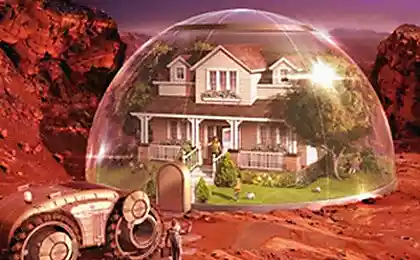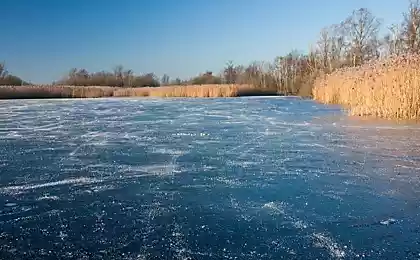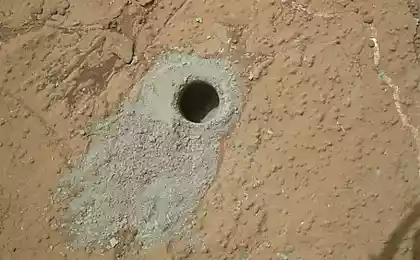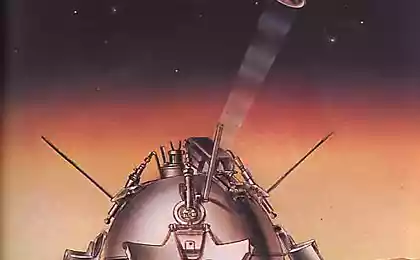671
Wind and ice on Mars

A look at Mars from orbit is a curious combination of a sense of the familiar and the unfamiliar. Somewhere you can see the sand dunes, it is the same as on Earth. At the poles are ice caps that give rise to the same winds that blow in the Antarctic. In warm areas of travel dust eddies, the physical principle of education which is similar to the vortices, which will tighten and take up light debris you outside in the summer. But at the same time, there are phenomena which are not present in the world. Not far from the spring pole hit the gas geysers, the dunes are visible polygons from the ice cracks. A little funny to know that blue sunset on Mars and red - on Earth generate the same physical laws. And it is very, very nice ...
DyunyNachat probably is here with this picture that looks almost at home. Sand dunes 300 kilometers from the polar ice cap at the North Pole, a composite image in infrared and visible light:

full size photo link
The connection of the visible and infrared gives us the image in false color - dunes really dark gray, they are heated by the sun and are painted in shades of yellow on the photo. A colder areas displaying shades of blue. The round white spot at the bottom of the photo -. High hill about 100 meters, covered with ice
But dunes on Mars
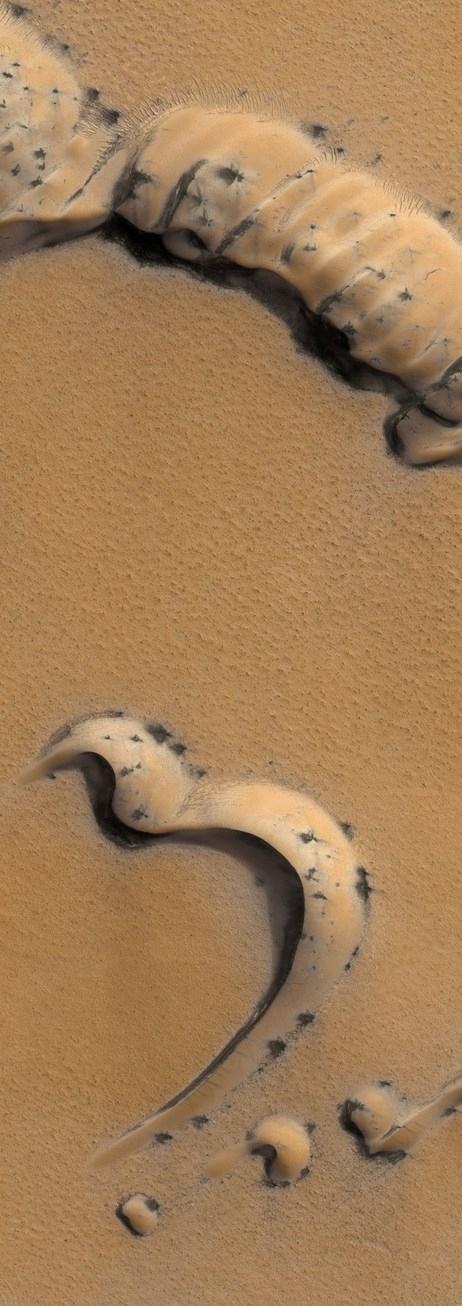
Dune - is the curved shape of the relief, which is formed when there is sand and wind. Wind stoned sand on the windward side, creating a gentle slope, which crumbles under the influence of gravity on the leeward side.
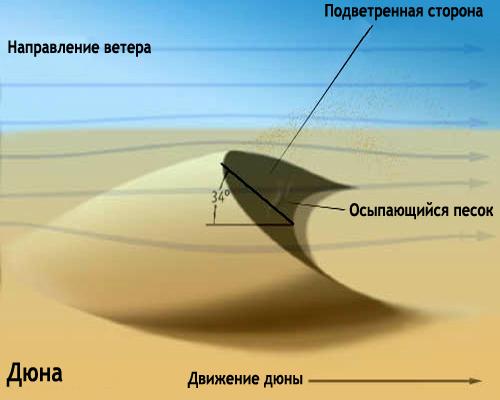
The angle of 34 ° is typical of terrestrial conditions. On Mars gravity lower and this leads to an interesting effect - the slope can be accumulated with a large angle, but when he started to crumble, it will crumble to a smaller angle than on Earth.
The dunes - an interesting thing. When the two are near the dune, they may merge into one, generate many new, smaller ones can be divided into two parts, and sometimes they are solitons, can pass through each other, retaining their shape:

In many ways, a wonderful film "Martian" could create a wrong impression of the Martian winds and sand storms. Do not forget that the pressure on the surface of Mars is about 1% of the ground, and the wind have to blow very fast to create any significant pressure. A Martian storms speed does not exceed 100 km / h, the earthly storms are faster. The density of the atmosphere is enough only for light wind and dust whirlwinds:

dust vortex formation mechanism is simple - the surface is heated by the sun, the heat transfers Ground layers of the atmosphere, and they become easier. At some point, the warm light air begins to rise upward, twisting due to the Coriolis force, and in its place comes the cold air above. On a sunny summer day in the world, you can often observe such vortices. In terrestrial conditions, dust vortices do not exceed several tens of meters in height (more thermals start, but they are not visible). But on Mars, you can take a picture of a vortex in the twenty kilometers high.

full size photo link
But in this picture, our brain is accustomed to look for familiar shapes easily find trees.

Full size picture height of 5400 pixels on the link
Did not notice? Here is part of a larger picture:

full size photo 2500 pixels wide by link
It looks like, right? Of course, this is not the trees. But in the world you can find a similar phenomenon. It landslides. Every spring, carbon dioxide ice is under the sand evaporates (carbon dioxide ice is not transferred to the liquid, and immediately turns into gas), and the sand coming from the top of the hill. And if you look closely at themselves hills can be found polygons cracking ice.
Close, not from orbit, the sublimation of the dry ice is as follows:
And what happens if the carbon dioxide will be in a flat area and under a thick layer of sand? Here's what:

Full-size photos, 15,000 pixels in height, the link
Dark "panicle" - a trace of precipitation dust raised by the gas erupting geyser. When the pressure of carbon dioxide at the bottom becomes too large, it breaks up, capturing with a primer. soil particles are lifted into the air and falling on the wind direction, so all the "whisk" in the same direction. On Earth, for this effect, there are no conditions.
You've probably already figured out that the carbon dioxide on Mars may be compared to water in the world, if we are talking about the time of year. Carbon dioxide snow falls in autumn and spring evaporates. And water on Mars for millennia is the ice, so it can be compared more with the stones of the Earth (important note - in the soil of Mars in some places there are perchlorates, which act as antifreeze and somewhere can make water a liquid, here it is a question of relatively pure water). For example, the ice in the crater near the north pole:

And here the north pole:

Do not you think that the dark cracks in the ice sheet are in a spiral? It is, and it is responsible for two things that are on earth - the Coriolis force and the katabatic wind. If about the Coriolis force, many have heard something (she rejects laterally moving objects on a rotating planet), something about the wind with a terrible name need to talk a little more. On Earth, there are wind map formed by the uneven heating of the surface (at the equator is greater at the poles - less)

Mars this effect is weaker, but the pressure is greater poles than at the equator. Therefore, the cold wind begins to blow toward the equator:

A planet's rotation deflects the wind side. Therefore, spiral fractures are formed. But the largest and most conspicuous fault - North Canyon (Chasma Boreale) has some kind of a long history, which until now scientists argue
.

Thanks to satellites, we can make a topographic map and virtually be on the surface of Mars.

full version of 4000 pixels wide by link
Since we are talking about the wind, it is the cause of the blue sunsets on Mars - dust in the atmosphere absorbs the red part of the spectrum of visible light, so the sky on Mars is reddish afternoon, and direct sunlight become blue. The same story with the Earth's atmosphere, but our atmosphere absorbs the blue part of the spectrum. Here's a Martian Lullaby.
Main source of inspiration for this publication has served this one post
Source: geektimes.ru/post/276002/


